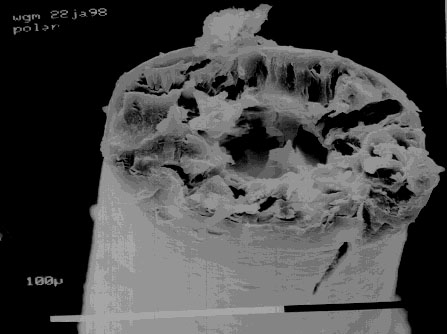
Cross section of polar bear fur. Image copyright 1998 by Bill May.
Polar bear fur is not a fiber optic
Here is an electron microscope image of a cross section of polar bear fur.
The image was taken by Bill May who holds the copyright it is used here by permission.
Notice the hollow center of the polar bear fur, notice how the hollow center has rough walls.

Cross section of polar bear fur. Image copyright 1998 by Bill
May.
A summary of UV measurements of Polar Bear fur by Prof. Koon can be found at:
http://it.stlawu.edu/~koon/polar.html
Professor Koon's statement is:
Polar bear hair does NOT behave fiber optically, either in the ultraviolet as originally claimed[1], or in the visible. This popular scientific myth has been propagated for over two decades by at least three teams of scientists [1-3] trying to explain why a polar bear's pelt appears black in the ultraviolet[4-7]. On closer inspection, the "fiber optic" claims made by three groups can be shown to be based on indirect, circumstantial evidence, and sometimes questionable interpretation of data. None of these three groups (nor any others) has yet claimed to have ever measured a significant amount of transmission of ultraviolet light -- say 1% -- through a significant length of hair -- say 1 inch. In fact, Tributsch et. al.[2] have shown that transmission in the UV is much lower than in the visible. So if fiber optics explained why the bear appears black in the UV, the polar bear would appear black to our eyes as well.
In fact, my own lab measurements[8] show that less than a thousandth of a percent of red light entering one end of a polar bear hair could travel the typical one-inch length. For ultraviolet light, the same amount of loss happens within, at most, one fifth the distance.
The bear's appearance in the UV can be explained[9] by invoking the known UV-absorbing properties of the protein keratin[10], of which the hair is composed. Keratin is simply much more strongly absorbing in the ultraviolet than in the visible.
references
http://it.stlawu.edu/~koon/mar_ref.html
The original incorrect paper states:
"Some light energy is conveyed to the collector, in this case the skin, by a complex process involving scattering form the inner core surface and reflection from the relatively smooth outer surfaces of the hairs. In this respect, the hairs are acting as light guides...The efficiency of transmission of solar radiation to the skin must be particularly high for the UV, since the pelts appear black when viewed in the UV while the hairs themselves appear quite transparent."
Grojean, R. E., Sousa, J. A., Henry, M. C., "Utilization of solar radiation by polar animals: an optical model for pelts", Applied Optics 19 (3), 339 (1980).
The most recent paper showing that polar bear fur is not fiber optic but is an absorber of UV.
"These measurements showed an exponential decay of 2, 3, 5, and 8 dB/mm at 650, 589, 545, and 450nm, respectively, which is consistent with the keratin."
data of Bendit and Ross [Appl. Spectrosc. 15, 103 (1961).] cited by Bohren and Sardie.[Appl. Opt. 20, 1894-6 (1981).]"
Koon, Daniel W., "Is polar bear hair fiber optic?", Applied Optics 37, 3198 (1998).
Return to Popular errors
|
Scientific Explorations with Paul Doherty |
|
24 June 2002 |